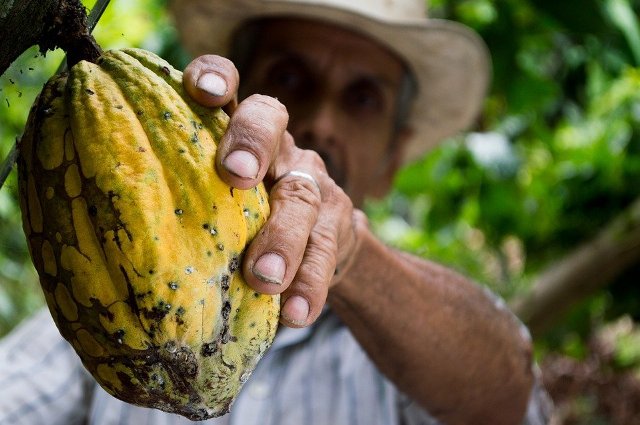Los indios americanos se reunían en Anguila para rendir homenaje a su dios Jocahu.

Today is World Cocoa Day, established by the International Cocoa Producers' Organization and the French Academy of Master Chocolatiers and Confectioners to remember and honor the benefits and properties of this product, a rich ambrosia that delights for its exquisiteness.
The aborigines in the Caribbean recognized it under the suggestive name of elixir of the gods, and although its history began more than 3,500 years ago, when the Olmecs discovered the plant in the Amazon basin (upper Amazon and Orinoco river basins), it is estimated that the ancient Mesoamerican settlers were the ones who discovered it.
It is attributed to them to have transported cocoa to Central America, from where it spread to the Amazon and Orinoco rivers. America, from where it spread to South America and Mexico, where it was used in rituals of the Mayan culture, and it is also said to have been used as a currency among pre-Hispanic cultures.
The process of domestication, cultivation and consumption of cocoa was initiated by the Toltec, Aztec and Mayan indigenous peoples in Mexico and Central America, who consumed it as a beverage called xocoatl, long before the arrival of the Spaniards. Its use by the Hispanics began in 1550 when nuns added candy and vanilla to chocolate.
The Spanish kept the secret of chocolate for 100 years before spreading it throughout Europe.
ALONG THE COCOA ROUTE
The Cocoa Route in the Caribbean and Latin America is a tourist modality that encompasses a set of activities and attractions It runs through dense plantations, aromatic crops and cocoa farms, and offers the vision of a lifestyle, of an era of our multifaceted culture.
The project, sponsored by UNESCO, covers various branches such as its origin in Latin America, presence and production in 17 countries, and it constitutes a cultural route that allows the establishment of links between communities with the aim of integral local development in cocoa-growing areas in relation to the safeguarding and management of cultural heritage.
The main objective of this initiative is to contribute to a knowledge about this crop and its ancestral practices, and to follow in the mark left by cocoa in the lives of those who cultivate it and nourish themselves with the traditions that surround it.
Let's take a look at some of the countries in Latin America and the Caribbean where this route exists.
COCOA ROUTE IN MEXICO
The Cocoa Route in Mexico has an illustrative expression in Chiapas and Tabasco, with cocoa plantations that can be visited to observe the elaboration of the exquisite chocolate, enjoying the colors and aromas of a great variety of plants and trees.
The tour allows you to see old manual machines used in the past, wooden and clay pots, molinillos, jícaras, comales, personal belongings of the old landowners and other interesting relics.
COCOA ROUTE IN THE DOMINICAN REPUBLIC
The Cocoa Routes in the Dominican Republic have a high representation in San Pedro de Macorís, in the northwest of the country, and it is there where those who hire one of these excursions can get close to the many curiosities that are produced around the Dominican cocoa; how the natives worked and how it is produced now, always following the organic production methods that are preserved in this Caribbean country to ensure that the cocoa has the best possible quality.
This cocoa trail includes learning about the different stages of the Dominican cocoa production process, starting, of course, with the cultivation.
COCOA ROUTE IN ECUADOR
The Cocoa Route in Ecuador is a project that integrates the production and tourism sectors to dynamize the value chain.
Among the activities include tours of the Organic Cocoa Museum, plantations and packing plants, horseback riding, local gastronomy and, of course, the cultural exchange with rural communities.
The canton of Naranjal, in the province of Guayas, has a vast agricultural production, in a plantation of approximately 340 hectares of cocoa, to the delight of visitors.
COCOA ROUTE IN CUBA
The Cacao Route project is added to the tourist attractions of Baracoa, and it begins on a trail located in the cacahual de Duaba, an area-laboratory where it is possible to appreciate the different transformations to which the acorn is subjected: from the planting of the seed in nurseries, sowing, harvesting, industrial processing, storage, up to the commercial network.
Cocoa production is dominated by the same basic agro-productive structure applied in its original plantations by more than a hundred French families who settled in the area between 1781 and 1804.
COCOA ROUTE IN COLOMBIA
The Cocoa Route in Colombia is very varied and it has a number of leading production departments: Santander, Arauca, Antioquia, Huila, Nariño and Tolima.
The Coffee Route can also be included in the excursions offered. In the case of cocoa, they allow you to visit the plantations to learn about the whole process behind the cultivation and processing of cocoa, as well as the possibility of making their own chocolate.
In addition, the tour includes a tasting of some of the products produced there.

Los indios americanos se reunían en Anguila para rendir homenaje a su dios Jocahu.